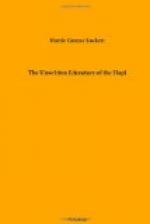[Footnote 31: Mindeleff, Victor, Op. cit. (Myths by Cosmos Mindeleff after Stephen), p. 31.]
Hough[32] says that in accord with the belief that the markings on the tail feathers were caused by the foam and slime of an ancient deluge, the feathers are prescribed for all pahos, since through their mythical association with water they have great power in bringing rain.
[Footnote 32: Hough, Walter, Op. cit, p. 172.]
X. CEREMONIES FOR BIRTH, MARRIAGE, BURIAL
* * * * *
The story of the Hopi, who does every important thing in his life according to a traditional pattern and accompanied by appropriate religious ceremony, would not be complete without some account of birth, marriage, and burial. Not having seen these ceremonies, the writer offers the record of authoritative observers.
=Birth=
Babies are welcomed and well cared for in Hopiland, and now that the young mothers are learning to discard unripe corn, fruit, and melons as baby food, the infant mortality, once very high, is decreasing.
Natal ceremonies are considered important. Goddard[33] gives us a brief picture of the usual proceedings: “The Hopi baby is first washed and dressed by its paternal grandmother or by one of her sisters. On the day of its birth she makes four marks with corn meal on the four walls of the room. She erases one of these on the fifth, tenth, fifteenth, and twentieth day of the child’s life. On each of these days the baby and its mother have their heads washed with yucca suds. On the twentieth day, which marks the end of the lying-in period, the grandmother comes early, bathes the baby and puts some corn meal to its lips. She utters a prayer in which she requests that the child shall reach old age and in this prayer gives it a name. A few of the women members of the father’s clan come in one at a time, bathe the baby and give it additional names. After the names have been given, the paternal grandmother goes with the mother and the child to




